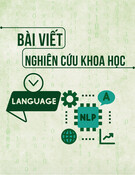
TNU Journal of Science and Technology
229(03): 127 - 134
http://jst.tnu.edu.vn 127 Email: jst@tnu.edu.vn
USING PEER FEEDBACK IN IMPROVING 10TH GRADE STUDENTS’
ENGLISH WRITING PERFORMANCE
Nguyen Viet Long1*, Nguyen Thi Minh Loan2, Nguyen Linh Duy3
1Hai Duong University
2TNU - School of Foreign Languages
3Cho Chu Secondary School – Dinh Hoa – Thai Nguyen
ARTICLE INFO
ABSTRACT
Received:
27/10/2023
The study was conducted with the hope that the result gained could
clarify the effects of peer feedback on students’ writing performance at
a high school, Thai Nguyen province. Based on the aims, an action
research design was employed. In order to achieve the goals, the
researcher conducted the study for 10 weeks with the participation of
30 students from class 10A1 at a high school. During the procedure of
the study, the students participated in writing lessons using the peer
feedback method by the teacher. The document analysis and the
questionnaire for students were chosen to be the data collection
instruments to find out the effects of using the peer feedback method on
the students’ writing performance after the intervention. The research
results showed that there was a remarkable improvement in the
students’ writing performance after the intervention and most of the
students had positive attitudes and good behavior towards the use of
peer feedback in writing lessons.
Revised:
18/01/2024
Published:
18/01/2024
KEYWORDS
Peer feedback
Student’s writing
Document analysis
Performance
Writing skills
SỬ DỤNG PHẢN HỒI ĐỒNG ĐẲNG TRONG VIỆC CẢI THIỆN KHẢ NĂNG
VIẾT TIẾNG ANH CỦA HỌC SINH LỚP 10
Nguyễn Việt Long1*, Nguyễn Thị Minh Loan2, Nguyễn Linh Duy3
1Trường Đại học Hải Dương
2Trường Ngoại ngữ - ĐH Thái Nguyên
3Trường THCS Chợ Chu – Định Hoá – Thái Nguyên
THÔNG TIN BÀI BÁO
TÓM TẮT
Ngày nhận bài:
27/10/2023
Nghiên cứu được thực hiện với hy vọng kết quả thu được có thể làm rõ
hơn ảnh hưởng của phản hồi đồng đẳng đến khả năng viết của học sinh
tại một trường trung học phổ thông thuộc tỉnh Thái Nguyên. Dựa trên
các mục tiêu, một thiết kế nghiên cứu hành động đã được sử dụng. Để
đạt được mục tiêu đề ra, nghiên cứu viên đã tiến hành nghiên cứu trong
thời gian 10 tuần với sự tham gia của 30 học sinh lớp 10A1 một trường
trung học phổ thông. Trong quá trình nghiên cứu, học sinh đã tham gia
viết bài bằng phương pháp phản hồi đồng đẳng của giáo viên. Việc
phân tích tài liệu và bảng hỏi dành cho sinh viên được chọn làm công
cụ thu thập số liệu nhằm tìm hiểu ảnh hưởng của việc sử dụng phương
pháp phản hồi đồng đẳng đến khả năng viết của học sinh sau can thiệp.
Kết quả nghiên cứu cho thấy sau can thiệp, khả năng viết của học sinh
có sự cải thiện rõ rệt và hầu hết học sinh đều có thái độ tích cực và
hành vi tốt đối với việc sử dụng phản hồi đồng đẳng trong giờ học viết.
Ngày hoàn thiện:
18/01/2024
Ngày đăng:
18/01/2024
TỪ KHÓA
Phản hồi đồng đẳng
Bài viết của học sinh
Phân tích tài liệu
Hiệu suất
Kỹ năng viết
DOI: https://doi.org/10.34238/tnu-jst.9069
* Corresponding author. Email: vietlong1231998@gmail.com

TNU Journal of Science and Technology
229(03): 127 - 134
http://jst.tnu.edu.vn 128 Email: jst@tnu.edu.vn
1. Introduction
Learning a second language or a foreign language has always included receiving feedback. In
terms of feedback kinds, various researchers have examined the usefulness of instructor feedback
in the learning of a second language. Peer assessment is investigated as a kind of feedback in this
paper. In today's world, learning English is no longer solely the responsibility of the language
teacher. Furthermore, the teaching and learning of English as a second or foreign language has
moved dramatically from a teacher-centered to a student-centered approach.
Peer feedback is beneficial because it assists students in comprehending the assessment
criteria and so allows for improvement based on those criteria. It also promotes a better
comprehension of the learning subject by highlighting students' strengths and weaknesses,
encourages participation, and assists students in comprehending the evaluation requirements [1].
Additionally, as [2] point out, active student participation in assessment design, choices, criteria,
and judgments is a more long-term preparation for later job life. In contrast to other modes of
assessment, according to [3], peer evaluation encourages students to be more active and
productive in a cooperative context. Peer evaluation is intricately incorporated into and aligned
with students' efforts during the instructional process [4]. Peer assessments improve students'
sense of responsibility for both the assessment process and the quality of their learning results,
which has a positive impact on their personal development.
According to [5], many students regard writing to be the hardest subject to study. It is not easy
for students to write in English. They feel bored because their teacher just asks them to open
dictionaries when they want to write. One research shows that problems in writing are as follows:
limited vocabulary 8%, difficulty in organizing ideas 16 %, no ideas to write 20 %, no motivation
to write 20 % and lack of confidence 36 % [6].
From the experience as a teacher at high school, the writer found some difficulties arising during
the process of teaching writing for the students at the pre-intermediate level such as content,
organization ideas, language, and mechanic use. In fact, they were complex problems that most
teachers encountered while teaching English at high schools. The consequence of this current issue
lied in the learners’ bad performance in writing activities, as in each examination [7]. Therefore, the
study focused on four aspects: vocabulary; content and organization of ideas; language use
(grammar); and mechanical use because the students lacked these aspects when they wrote in English.
It was suggested that using peer feedback should improve learners’ writing skills; thenceforward,
boosting learners’ writing performance [8]. This had taken the concern of many teachers.
To accomplish the aims, the study would be carried out with the hope of setting up tentative
answers to the two following questions:
1. How does peer feedback improve the students’ writing performance?
2. What are the students’ attitudes towards the application of peer feedback in writing performance?
2. Methodology
2.1. Action research design
The researcher adopted the action research approach to examine the effects of using peer
feedback on 10th grade students’ writing skills at a high school in the second semester of the
school year 2021/2022.
2.2. Subjects of the study
The study involved 30 10th grade students at a high school in Thai Nguyen province who had
been studying English for at least seven years and were at the elementary to pre-intermediate
level. The researcher selected students from class 10A1 due to their greater experience in
learning English and better writing ability than other classes. The researcher was also the teacher
of the class and wanted to find a way to help students with their writing skills. The class had an
extra English period per week, making it an ideal choice for the study.

TNU Journal of Science and Technology
229(03): 127 - 134
http://jst.tnu.edu.vn 129 Email: jst@tnu.edu.vn
2.3. Data collection instruments
Two data collection instruments were utilized in the study, including document analysis and a
questionnaire.
2.4. Research design
The process of incorporating peer feedback into a course involves several key steps. Step 1
entails comprehensive planning, beginning with the evaluation of how peer feedback aligns with
the course's framework and objectives. Additionally, designing peer-feedback worksheets tailored
for the feedback session is crucial during this phase. Step 2 involves taking action, implementing
the planned peer-feedback system within the course structure. Step 3 focuses on observation,
closely monitoring the peer-feedback sessions and their impact on the learning environment.
Finally, step 4 centers on reflection, allowing for an assessment of the effectiveness of the peer-
feedback process, identifying areas for improvement, and considering its overall contribution to the
learning experience. Each step plays a pivotal role in successfully integrating peer feedback into the
course, fostering a collaborative and enriching learning environment for students.
2.5. Data analysis procedures
For analysis, the researcher collected the first and final drafts of each lesson to analyze and
evaluate. The outcomes of the tests would examine using the Microsoft Excel application.
3. Findings
3.1. Findings from the first and final drafts
3.1.1. Feedback on content and ideas organization
The two main points in ideas organization the students were expected to give feedback to are the
topic sentence and supporting ideas of the whole paragraph. Students were informed to focus on
these four main points when giving feedback to their peers. The data analysis showed that not many
students focused on the mistakes related to covering all genres as revealed in Figure 1.
Figure 1. The percentage of students who gave feedback
Based on Figure 1, the students gave the least feedback on fluent expression (10%) and the
most feedback on topic sentence (45%). Feedback on well-organized and supporting ideas was
moderate, at 20% and 35% respectively.
Table 1. Student’s improvement after receiving peer feedback
Aspects
The number of mistakes indicated
in the first drafts
The number of mistakes indicated
in the second drafts
Topic sentence
13
3
Fluent expression
10
0
Well-organized
15
2
Supporting ideas
17
5
45
10 20
35
0
10
20
30
40
50
Topic sentence fluent expression well-organized Supporting ideas

TNU Journal of Science and Technology
229(03): 127 - 134
http://jst.tnu.edu.vn 130 Email: jst@tnu.edu.vn
According to table 1, there were 55 mistakes related to paragraph organization in the first
drafts and 10 of them were corrected in the second drafts, which is 18%. Out of the 10 corrected
mistakes, 3 were related to the topic sentence, 0 were related to fluent expression, 2 were related
to well-organized, and 5 were related to supporting ideas. The lowest correction rate was for
fluent expression (0%) while the highest correction rate was for supporting ideas (50%). The
correction rate for topic sentence was around 30%.
3.1.2. Feedback on grammar
In contrast to covering all genres, all the students paid attention to grammar when they gave
feedback to their peers. They indicated the mistakes for their peers by underlining the mistakes
and using the symbols to call out the name of mistakes.
Figure 2. The percentage of students who provided suggestions for the grammatical mistakes
Although all the students indicated the mistakes of grammar, not all of them provided
suggestion for correcting mistakes. This is shown in figure 2 in which 52% the students provided
suggestion while 48% of them did not.
The table 2 provides valuable insights into the number of mistakes indicated, along with the
corresponding counts of correct and incorrect suggestions made by the students.
Table 2. Students' giving feedback on grammar
Types of grammatical
mistakes
The number of
mistakes indicated
The number of correct
suggestions
The number of incorrect
suggestions
The use of verbs
110
53
6
Articles
11
2
1
Preposition
10
5
2
Tenses
7
3
1
Total
138
62
10
As shown in table 2, there were totally 138 indicated mistakes of the four types. However, the
mistakes indicated in each type had different percentage. The highest percentage belongs to the
mistakes related to the use of verbs (80%). The number of mistakes related to articles and
preposition were nearly the same (one was 8% and the other was 7%). The number of tense
mistakes indicated was the lowest with only 5%.
Table 3 illustrates a comparison between the number of grammatical errors present in
students' initial drafts and the subsequent enhancements observed in their second drafts following
the reception of peer feedback.
Table 3. Students' giving feedback on grammar after receiving peer feedback
Types of mistakes
The number of mistakes in the first drafts
The number of mistakes in the second drafts
The use of verbs
120
100
Articles
11
9
Preposition
10
7
Tenses
50
35
52%
48% Students provided suggestions
Students did not provide suggestions

TNU Journal of Science and Technology
229(03): 127 - 134
http://jst.tnu.edu.vn 131 Email: jst@tnu.edu.vn
In a total of 191 grammar mistakes changed correctly, the number of mistakes related to the
use of verbs was 120, articles were 11, prepositions were 10, and tenses was 50. In comparison to
the number of mistakes indicated in the first drafts, the percentage of the use of verbs mistakes
changed correctly in the second drafts was highest (83%). The percentage of corrected changes
related to the use of articles was 81% and the lowest percentage belonged to the preposition and
tenses, about 70%.
3.1.3. Feedback on vocabulary
In addition to grammar, vocabulary plays a crucial role in enhancing students' writing skills.
As a result, when offering written feedback on their classmates' writing, students tend to focus
heavily on vocabulary. This is evident from the fact that all students identified errors and used
symbols to highlight them. However, after identifying the errors, not all students suggested ways
to rectify them. Only 38% of the students offered suggestions, while 62% did not. Figure 3
illustrates this trend quite clearly.
Figure 3. The percentage of students who provided suggestions for the vocabulary mistakes
Of all the vocabulary mistakes in writing, the most mistakes that students made were those
related to word form, word order, word choice. Therefore, only these kinds of mistakes were
examined more closely to see whether the feedback actually helped students improve their use of
vocabulary in writing or not.
Table 4. Students' giving feedback on vocabulary
Types of vocabulary
mistakes
Total number of
mistakes indicated
The number of the
correct suggestions
The number of incorrect
suggestions
Word order
13
1
1
Word choice
40
17
3
Word form
16
2
2
According to table 4, there were totally 69 indicated mistakes of the four types. However, the
mistakes indicated in each type had different percentage. The highest percentage belonged to the
mistakes related to the word choice (58%). The percentage of mistakes related to word form was
23% and the rest was the word order (19%).
Table 5. Students' giving feedback on vocabulary after receiving peer feedback
Types of vocabulary mistakes
The number of mistakes
in the first drafts
The number of mistakes
in the second drafts
Word order
13
10
Word choice
40
22
Word form
18
7
Based on the information table 5 provided, it appeared that among the 71 vocabulary mistakes
corrected in the second drafts, 13 were related to word order, 18 were related to word form, and
40 were related to word choice. The highest percentage of correctly changed mistakes was related
38%
62%
Students provided suggestions
Students did not provide suggestions



![Mẫu câu viết thư thân mật bằng Tiếng Anh [Chuẩn Nhất]](https://cdn.tailieu.vn/images/document/thumbnail/2025/20250708/caotiendat91211.thd2017@gmail.com/135x160/80151751961845.jpg)
![Tài liệu gợi ý viết email tiếng Anh và 35 đề thi mẫu [chuẩn SEO]](https://cdn.tailieu.vn/images/document/thumbnail/2025/20250708/caotiendat91211.thd2017@gmail.com/135x160/25321751961846.jpg)






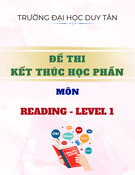
![Đề cương môn Tiếng Anh 1 [Chuẩn Nhất/Mới Nhất]](https://cdn.tailieu.vn/images/document/thumbnail/2025/20251130/cubabep141@gmail.com/135x160/51711764555685.jpg)


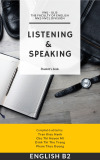
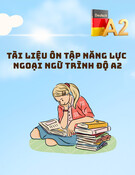




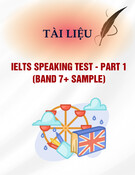

![Mẫu thư Tiếng Anh: Tài liệu [Mô tả chi tiết hơn về loại tài liệu hoặc mục đích sử dụng]](https://cdn.tailieu.vn/images/document/thumbnail/2025/20250814/vinhsannguyenphuc@gmail.com/135x160/71321755225259.jpg)
